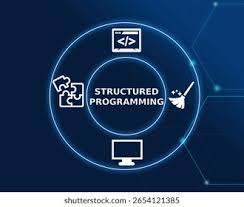
Structured Programming – Summary
Definition
Structured programming is a programming paradigm that emphasizes writing clear, logical programs using a top-down approach. It avoids unstructured jumps like goto and is built around three main control structures.
Key Concepts
1. Sequence
o Instructions are executed in order, one after the other.
2. Selection (Decision-making)
o Allows the program to choose different paths using if, if...else, or switch.
3. Iteration (Loops)
o Repeats actions using loops like for, while, or do...while.
Features
- Uses modular design (programs are divided into functions/modules).
- Improves code readability and maintainability.
- Encourages reuse of code through functions.
- Enhances debugging and testing.
- Avoids goto statements for better flow control.
Advantages
- Easier to understand, modify, and debug.
- Reduces development time.
- Promotes code reuse.
- Supports logical flow and good programming practices.
Applications
Structured programming is used in almost all modern languages like C, Python, Java, etc., and is ideal for building small to moderately complex applications.
- Teacher: NDIWA DANIEL
